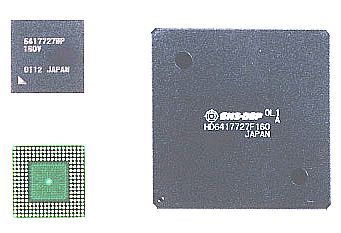|
Tokyo, June 4, 2001--- Hitachi, Ltd. (TSE: 6501) today announced
the SH7727, with a 160 MHz/100 MHz operating frequency incorporating
a USB (Universal Serial Bus) Host, together with a USB Function and
color LCD controller, on a single chip. Sample shipments will begin
in July 2001 in Japan.
This product incorporates a high-performance SuperHTM*1
RISC engine family 32-bit RISC microcomputer SH3-DSP CPU core, enabling
high-speed voice and image middleware compression/decompression processing.
It also provides a comprehensive range of peripheral functions, including
a USB Host, USB Function, and color LCD controller, on a single chip,
making it possible to design multimedia products such as portable
information terminals and multifunctional phones supporting internet
application that offer higher performance in a more compact size and
at lower cost.
With the remarkable advances made in the multimedia field in recent
years, the task of interfacing a PC to its peripherals has come to
be handled by the USB interface, which allows high-speed transfer
of large volumes of data, including voice and image, and many PCs
now incorporate a USB Host. In line with this, more printers and other
peripheral devices now include a USB Function--the facility that handles
data exchange--and a built-in USB Function is also being increasingly
found in multimedia products such as portable information terminals
and digital still cameras. However, connecting a portable information
terminal directly to a printer, for instance, requires one of the
devices to be equipped with a USB Host, a requirement that has previously
been met by means of a dedicated LSI. In developing multimedia products
and peripheral devices with a built-in USB Host, therefore, there
is a strong demand for a single-chip implementation that will allow
both size and cost to be reduced. Meanwhile, digital information services,
including internet e-mail and image display, are becoming more widely
available for stationary consumer phones and fax machines. The trend
is thus one of increasing devices for multimedia, including multifunctionality
and color displays, and there is a demand for semiconductor devices
that can provide these features by means of digital data processing.
The SH7727 now being released meets these needs by offering the following
features.
| (1) |
Incorporating USB Host and USB Function
compliant with USB Standard Rev. 1.1 compliant The USB Host supports
isochronous, interrupt, control, and bulk transfer, allowing a
maximum data transfer speed of 12 Mbps (bits per second), and
also complies with OpenHCI (Open Host Controller Interface) specifications,
facilitating porting of device driver software from PC driver
software, for example. The USB Function supports interrupt, control,
and bulk transfer, and also incorporates a transceiver that eliminates
the need for external parts such as buffers. |
| (2) |
Incorporating color LCD controller
The color LCD controller supports STN, DSTN, and TFT liquid crystal
panels. The memory for storing display image data employs a UMA
(Unified Memory Access) architecture, and is shared with system
memory. Display of up to 65,536 colors is possible with a 640
× 480-dot screen size, for example. A 2.4-Kbyte line memory
buffer is also provided, enabling high-speed drawing of large
volumes of data. |
| (3) |
Enabling high-speed processing by incorporating
high-performance SH3-DSP 32-bit CPU core High processing performance
of 208 MIPS and 320 MOPS at 160MHz operating frequency enables
high-speed voice and image middleware processing, including MP3*2,
ADPCM*3, and JPEG*4,
and also allows VoIP protocol processing used in internet telephone,
and the like. |
The SH7727 also incorporates a variety of peripheral functions. In addition
to specialized functions such as an interface allowing connection to
an AFE (Analog Front End) IC and an interface enabling direct connection
to an Audio CODEC IC for music playback, the SH7727 offers a comprehensive
set of on-chip peripheral functions that include an MMU (Memory Management
Unit) and DMAC memory management function, A/D and D/A converters for
analog signal processing, interfaces for various kinds of memory including
synchronous DRAM, and an IrDA (Infrared Data Association) Ver.1.0, PCMCIA
controller for infrared communication.
In addition, the provision of on-chip debugging functions (H-UDI and
AUD)*5 allows real-time emulation at the maximum
operating frequency using the E10A PC card emulator development tool.
Two kinds of package are supported: a 240-pin HQFP and 240-pin CSP.
Use of the SH7727 will simplify the development of products incorporating
a USB interface, and also, thanks to its comprehensive set of peripheral
functions, make it possible to reduce the number of external parts and
create a high-performance system in a more compact size and at lower
cost.
The SuperH family product lineup will be further enhanced in the future
in response to market needs, and development will also continue on products
offering higher performance together with lower power consumption.
| Notes: 1. |
SuperH is a trademark of Hitachi, Ltd. |
| 2. |
MP3: MPEG-1 Audio Layer 3. MPEG is an
abbreviation of Moving Picture Experts Group. MPEG is an international
standard for compression/decompression of color moving pictures
including audio, such as video. MP3 is a compression/decompression
standard relating to MPEG audio. |
| 3. |
ADPCM: Adaptive Differential Pulse Code
Modulation, a typical audio data compression/decompression method
using differentials. |
| 4. |
JPEG: Joint Photographic Experts Group,
an international standard for color still image compression/decompression. |
| 5. |
On-chip debugging functions (Hitachi-User
Debug Interface, Advanced User Debugger): Part of the debugging
circuitry previously incorporated in an emulator. The inclusion
of these functions enables real-time emulation at the actual microcomputer
operating frequency during system evaluation, etc. |





|



